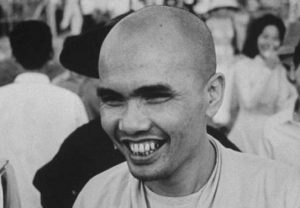
When people die, we have rituals and traditions to guide us through the process. Most of them are designed to help those who have been left behind. Family and friends gather and sit with the survivors. Neighbors bring food. There are guidelines to follow regarding burial or cremation and who will officiate and when they must occur. There are informal, perhaps even formal rules around what color to wear. In the West, it is very traditional to wear black. You can live in the West and wear white for mourning, as would be traditional in the Cambodian culture. Your family might follow Thai traditions and the family will wear black, and if there is a widow, she will wear purple. Or you might all wear tropical prints because the deceased loved Hawai‘i. You might meet on the beach and paddle out into the water and release flowers. Maybe you will hold a New Orleans-style jazz funeral. There are so many different ways in which we mourn our loss or celebrate a life or both. I do not think that these rituals magically erase the grief, but they help. They bring us together and provide a sense of community. But what about when it is a pet who has died? I think we are still figuring this out.
When I was a child and our puppy died, I had no idea what happened to her after the fact. She disappeared and I missed her. Now, when one of the cats has died, the veterinarian provides cremation services. It seems to me that the first time I brought a cat to be cremated, they took the body and offered me condolences. The last time or two, I was asked if I wanted to keep the ashes. In light of the fact that you can have a burial and a ceremony or even release the ashes, this makes sense. You might decide to keep the ashes. And if you do not bury them or keep them in an urn or release them, you can have those ashes made into pottery or even jewelry. You can have your pet taxidermized, you can opt for cloning, or you can have a portrait painted. There are services that will make a stuffed animal which resembles your pet as closely as possible. There are other ways to celebrate the life of your pet and to mourn the loss of your pet. I hope that you will make a decision that supports you in your Buddhist practice. Something that helps you step toward the release of suffering.
Recently, I encountered a story that makes my heart happy. And I hope it will do the same for you. Kevin Curry learned that his dog, Mellow, had lymphoma. Mellow was dying. Many of the neighbors knew Mellow as he and Kevin walked together twice a day, every day, rain or shine. Kevin decided that Mellow needed a send-off. A final walk around the neighborhood. Kevin prepared a special letter and left it in mailboxes all along their usual walking route.
“I will be marching around the neighborhood on Saturday, 3 June from 7–8 p.m. and would love to say goodbye to you face-to-face if you are available,” Curry wrote in the letter on Mellow’s behalf. “Come out to pat me on the head or rub my belly and I will be forever grateful (I love people after all).”
Kevin set out on the day and time of the final walk, expecting a small turnout of supportive neighbors. There were crowds of people: children made signs; some people brought their dogs. Mellow had the best possible experience. He was a rescue dog who lived his best life and was loved by many.

We can hope that after Mellow died, friends and neighbors continued to check in on Kevin and remind him that, like his dog, he is loved. That is what we can do for our friends and colleagues and family members after they lose a cherished pet.
I knew that my neighbor’s elderly cat Jack had died when I found extra litter and food on my front porch. The note attached stated that this was an inheritance to my cat from Jack. While my neighbor did not want to talk about it too much, it was acceptable for me to occasionally refer to the inheritance. And as time passed, we were able to make up stories about the inheritance. Like the fact, that perhaps there was a key to a safe-deposit box in the litter, and that in that safe-deposit box was treasure. But then we realized that the treasure was probably cans of tuna!
After your pet dies and you decide whether or not to have a burial or a cremation or a ceremony—or nothing—you will still be faced with your own grief. Seek to make choices around how you say goodbye that support your ability to move forward on your spiritual path. This requires self-awareness and honesty on your part. Will keeping a picture or a statue or a plush version of your pet? Or taxidermy or cloning or ashes? What will allow you to fully express your grief and ultimately accept the fact that your sweet critter is gone? Your work now is to be with your grief in a way that helps you find a release from suffering.
1 “Man Takes Dying Dog for Final Walk around PA Neighborhood — and Neighbors Show out Big,” accessed 6 August 2023, https://www.yahoo.com/news/man-takes-dying-dog-final-140738368.html.
See more
Margaret Meloni: Death Dhamma
The Death Dhamma Podcast (Margaret Meloni)
Related features from BDG
Reflecting on the Choice of Memorializing Loved Ones
Our Pets, Our Teachers
The Promise of Impermanence
Related videos from BDG
The Death Dhamma Podcast Season 1
The Death Dhamma Podcast Season 2












